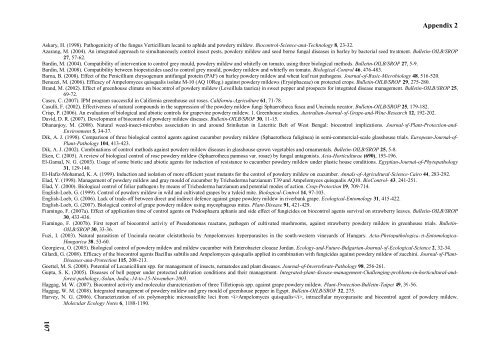Classical and augmentative biological control against ... - IOBC-WPRS
Classical and augmentative biological control against ... - IOBC-WPRS
Classical and augmentative biological control against ... - IOBC-WPRS
Create successful ePaper yourself
Turn your PDF publications into a flip-book with our unique Google optimized e-Paper software.
Appendix 2<br />
Askary, H. (1998). Pathogenicity of the fungus Verticillium lecanii to aphids <strong>and</strong> powdery mildew. Bio<strong>control</strong>-Science-<strong>and</strong>-Technology 8, 23-32.<br />
Azarang, M. (2004). An integrated approach to simultaneously <strong>control</strong> insect pests, powdery mildew <strong>and</strong> seed borne fungal diseases in barley by bacterial seed treatment. Bulletin-OILB/SROP<br />
27, 57-62.<br />
Bardin, M. (2004). Compatibility of intervention to <strong>control</strong> grey mould, powdery mildew <strong>and</strong> whitefly on tomato, using three <strong>biological</strong> methods. Bulletin-OILB/SROP 27, 5-9.<br />
Bardin, M. (2008). Compatibility between biopesticides used to <strong>control</strong> grey mould, powdery mildew <strong>and</strong> whitefly on tomato. Biological-Control 46, 476-483.<br />
Barna, B. (2008). Effect of the Penicillium chrysogenum antifungal protein (PAF) on barley powdery mildew <strong>and</strong> wheat leaf rust pathogens. Journal-of-Basic-Microbiology 48, 516-520.<br />
Benuzzi, M. (2006). Efficacy of Ampelomyces quisqualis isolate M-10 (AQ 10Reg.) <strong>against</strong> powdery mildews (Erysiphaceae) on protected crops. Bulletin-OILB/SROP 29, 275-280.<br />
Br<strong>and</strong>, M. (2002). Effect of greenhouse climate on bio<strong>control</strong> of powdery mildew (Leveillula taurica) in sweet pepper <strong>and</strong> prospects for integrated disease management. Bulletin-OILB/SROP 25,<br />
69-72.<br />
Casey, C. (2007). IPM program successful in California greenhouse cut roses. California-Agriculture 61, 71-78.<br />
Casulli, F. (2002). Effectiveness of natural compounds in the suppression of the powdery mildew fungi Sphaerotheca fusca <strong>and</strong> Uncinula necator. Bulletin-OILB/SROP 25, 179-182.<br />
Crisp, P. (2006). An evaluation of <strong>biological</strong> <strong>and</strong> abiotic <strong>control</strong>s for grapevine powdery mildew. 1. Greenhouse studies. Australian-Journal-of-Grape-<strong>and</strong>-Wine-Research 12, 192-202.<br />
David, D. R. (2007). Development of bio<strong>control</strong> of powdery mildew diseases. Bulletin-OILB/SROP 30, 11-15.<br />
Dhananjoy, M. (2008). Natural weed-insect-microbes association in <strong>and</strong> around Sriniketan in Lateritic Belt of West Bengal: bio<strong>control</strong> implications. Journal-of-Plant-Protection-<strong>and</strong>-<br />
Environment 5, 34-37.<br />
Dik, A. J. (1998). Comparison of three <strong>biological</strong> <strong>control</strong> agents <strong>against</strong> cucumber powdery mildew (Sphaerotheca fuliginea) in semi-commercial-scale glasshouse trials. European-Journal-of-<br />
Plant-Pathology 104, 413-423.<br />
Dik, A. J. (2002). Combinations of <strong>control</strong> methods <strong>against</strong> powdery mildew diseases in glasshouse-grown vegetables <strong>and</strong> ornamentals. Bulletin-OILB/SROP 25, 5-8.<br />
Eken, C. (2005). A review of <strong>biological</strong> <strong>control</strong> of rose powdery mildew (Sphaerotheca pannosa var. rosae) by fungal antagonists. Acta-Horticulturae (690), 193-196.<br />
El-Gamal, N. G. (2003). Usage of some biotic <strong>and</strong> abiotic agents for induction of resistance to cucumber powdery mildew under plastic house conditions. Egyptian-Journal-of-Phytopathology<br />
31, 129-140.<br />
El-Hafiz-Mohamed, K. A. (1999). Induction <strong>and</strong> isolation of more efficient yeast mutants for the <strong>control</strong> of powdery mildew on cucumber. Annals-of-Agricultural-Science-Cairo 44, 283-292.<br />
Elad, Y. (1998). Management of powdery mildew <strong>and</strong> gray mould of cucumber by Trichoderma harzianum T39 <strong>and</strong> Ampelomyces quisqualis AQ10. BioControl- 43, 241-251.<br />
Elad, Y. (2000). Biological <strong>control</strong> of foliar pathogens by means of Trichoderma harzianum <strong>and</strong> potential modes of action. Crop-Protection 19, 709-714.<br />
English-Loeb, G. (1999). Control of powdery mildew in wild <strong>and</strong> cultivated grapes by a tydeid mite. Biological-Control 14, 97-103.<br />
English-Loeb, G. (2006). Lack of trade-off between direct <strong>and</strong> indirect defence <strong>against</strong> grape powdery mildew in riverbank grape. Ecological-Entomology 31, 415-422.<br />
English-Loeb, G. (2007). Biological <strong>control</strong> of grape powdery mildew using mycophagous mites. Plant-Disease 91, 421-429.<br />
Fiamingo, F. (2007a). Effect of application time of <strong>control</strong> agents on Podosphaera aphanis <strong>and</strong> side effect of fungicides on bio<strong>control</strong> agents survival on strawberry leaves. Bulletin-OILB/SROP<br />
30, 433-436.<br />
Fiamingo, F. (2007b). First report of bio<strong>control</strong> activity of Pseudomonas reactans, pathogen of cultivated mushrooms, <strong>against</strong> strawberry powdery mildew in greenhouse trials. Bulletin-<br />
OILB/SROP 30, 33-36.<br />
Fuzi, I. (2003). Natural parasitism of Uncinula necator cleistothecia by Ampelomyces hyperparasites in the south-western vineyards of Hungary. Acta-Phytopathologica-et-Entomologica-<br />
Hungarica 38, 53-60.<br />
Georgieva, O. (2003). Biological <strong>control</strong> of powdery mildew <strong>and</strong> mildew cucumber with Enterobacter cloacae Jordan. Ecology-<strong>and</strong>-Future-Bulgarian-Journal-of-Ecological-Science 2, 32-34.<br />
Gilardi, G. (2008). Efficacy of the bio<strong>control</strong> agents Bacillus subtilis <strong>and</strong> Ampelomyces quisqualis applied in combination with fungicides <strong>against</strong> powdery mildew of zucchini. Journal-of-Plant-<br />
Diseases-<strong>and</strong>-Protection 115, 208-213.<br />
Goettel, M. S. (2008). Potential of Lecanicillium spp. for management of insects, nematodes <strong>and</strong> plant diseases. Journal-of-Invertebrate-Pathology 98, 256-261.<br />
Gupta, S. K. (2005). Diseases of bell pepper under protected cultivation conditions <strong>and</strong> their management. Integrated-plant-disease-management-Challenging-problems-in-horticultural-<strong>and</strong>forest-pathology,-Solan,-India,-14-to-15-November-2003.<br />
Haggag, M. W. (2007). Bio<strong>control</strong> activity <strong>and</strong> molecular characterization of three Tilletiopsis spp. <strong>against</strong> grape powdery mildew. Plant-Protection-Bulletin-Taipei 49, 39-56.<br />
Haggag, W. M. (2008). Integrated management of powdery mildew <strong>and</strong> grey mould of greenhouse pepper in Egypt. Bulletin-OILB/SROP 32, 275.<br />
Harvey, N. G. (2006). Characterization of six polymorphic microsatellite loci from Ampelomyces quisqualis, intracellular mycoparasite <strong>and</strong> bio<strong>control</strong> agent of powdery mildew.<br />
Molecular Ecology Notes 6, 1188-1190.<br />
107

















